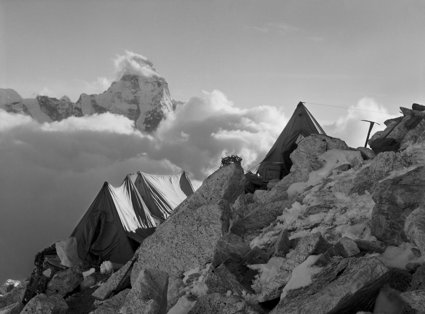
Everest 1953 limited edition platinum prints
The first ever limited-edition series of platinum prints from photographs taken on the 1953 Mount Everest Expedition.
To mark the 70th anniversary of the first successful ascent of Mount Everest by Tenzing Norgay and Edmund Hillary on 29 May 1953, the Society has collaborated with the Salto Ulbeek studio in Belgium to create the first ever limited edition series of platinum prints from photographs taken on the 1953 Mount Everest Expedition. These nine museum-grade prints will be hand-made to order by the master printmaker Georges Charlier and his team at Salto Ulbeek. The digitisation and printing techniques used by Salto Ulbeek have opened up these exceptional photographs, providing greater clarity and breathtaking detail in every print.
"We agreed that this was going to be no ordinary climb. For the time being, Everest was rather more than a mountain."
John Hunt, leader of the 1953 Mount Everest Expedition
Since the 1921 British Mount Everest Reconnaissance Expedition, there had been a further eight expeditions to Everest, all with the aim to summit the world’s highest mountain. Until 1953 all had been unsuccessful.
Following identification of “a practicable route from the West Cwm to the summit of Mount Everest" by the British Mount Everest Reconnaissance Expedition in 1951, a further expedition was planned. John Hunt was appointed leader of the 1953 British Mount Everest Expedition and brought together a group of climbers who together would make the ninth attempt to summit the lofty peak.
Base Camp was established on 12 April 1953 and nine further camps were established from the Khumbu Glacier, through the Khumbu Icefall, up the Western Cwm and on to the South Col of Everest. By 21 May, Wilfred Noyce and Annullu had reached the South Col, a symbolic and crucial objective.
The final objective, however, was the summit. On 26 May, the first assault party, comprising Tom Bourdillon and Charles Evans, set off for the South Summit. At the South Summit they realised that they would not be able to reach the summit owing to lack of time so, wearily, they turned back.
On 28 May, the second assault party comprising Edmund Hillary and Tenzing Norgay made their bid. With support from George Lowe, Alfred Gregory and Ang Nyima they established Camp IX at 27,900 feet (8503 m), before watching their companions head back down the mountain to the South Col. After a bitterly cold and desolate night, Hillary and Tenzing rose at 4.00am and began preparing themselves for their attempt on the summit. Using open-circuit oxygen equipment they departed at 6.30am and climbed steadily, reaching the South Summit at 9.00am After a further two and a half hours of perseverance they overcame their final obstacle; a steep ridge of rock and ice – now called the Hillary Step. It was 11.30am on Friday 29 May 1953 and Tenzing Norgay and Edmund Hillary had reached the highest point on the earth.
"My initial feelings were of relief – relief that there were no more steps to cut – no more ridges to traverse – no more humps to tantalize us with hopes of success. I looked at Tenzing, and despite of the balaclava, goggles and oxygen mask, all encrusted with long icicles that concealed his face, there was no disguising his infectious grin of pure delight as he looked all around him."
Edmund Hillary in The Ascent of Everest (1953) by John Hunt
Taken by Edmund Hillary, John Hunt and Alfred Gregory, these dramatic images capture the extraordinary stories of human endeavour and challenge to reach the summit of the world’s highest mountain.
The Society is internationally renowned for our iconic collection of photographs documenting Everest - the world’s largest archive of the highest mountain. Today, the Everest collection at the Society provides a remarkable source of archive and visual material for research purposes, to better share the knowledge and expertise of all involved in the successive attempts to reach the summit of the world’s highest mountain.
Alfred Gregory, official photographer to the 1953 Mount Everest Expedition, photographed some of the most famous of the expedition’s images, including the last photograph of Tenzing and Hillary on the South-East Ridge before they started off for the summit and as they celebrated their success following their successful summit.
Everest 1953 Platinum Prints
Contact us
For more information and purchasing details, please contact images@rgs.org
